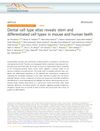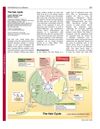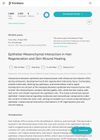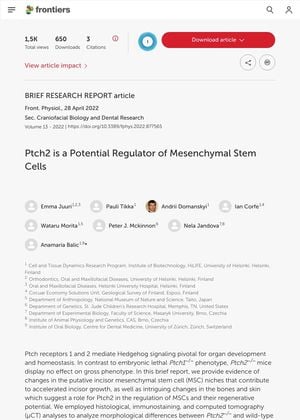TLDR Ptch2 plays a key role in controlling stem cell function and the ability to regenerate after birth.
The study "Ptch2 is a Potential Regulator of Mesenchymal Stem Cells" found that Ptch2, a receptor in the Hedgehog signaling pathway, plays a significant role in regulating stem cell function and postnatal regenerative capacity. The absence of Ptch2 in mutant mice led to changes in tissues where Ptch2 is co-expressed with Ptch1, affecting the mesenchymal stem cells (MSCs) and their regenerative and differentiation potential. This was observed in the teeth, long bones, and skin of the mice. The study also found that Ptch2 regulates Hh signaling mainly through the Gli1 protein. Therefore, Ptch2 is a critical regulator of stem cell function and postnatal regenerative capacity.
 116 citations
,
September 2020 in “Nature Communications”
116 citations
,
September 2020 in “Nature Communications” The research identified various cell types in mouse and human teeth, which could help in developing dental regenerative treatments.
 145 citations
,
November 2018 in “Nature Communications”
145 citations
,
November 2018 in “Nature Communications” The Sonic hedgehog pathway is crucial for new hair growth during mouse skin healing.
363 citations
,
March 2017 in “Nature Communications” 20 citations
,
November 2014 in “Developmental Dynamics” Palate formation and skin healing share similar biological processes.
 375 citations
,
February 2006 in “Journal of Cell Science”
375 citations
,
February 2006 in “Journal of Cell Science” The document concludes that the hair cycle is a complex process involving growth, regression, and rest phases, regulated by various molecular signals.
 103 citations
,
January 2006 in “Journal of Cell Science”
103 citations
,
January 2006 in “Journal of Cell Science” The document concludes that the hair cycle is a complex process involving growth, regression, and rest phases, regulated by various molecular signals.
 5 citations
,
April 2022 in “Frontiers in Medicine”
5 citations
,
April 2022 in “Frontiers in Medicine” Hair and skin healing involve complex cell interactions controlled by specific molecules and pathways, and hair follicle cells can help repair skin wounds.





